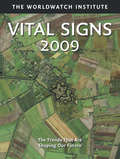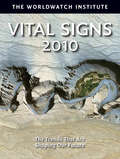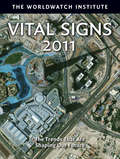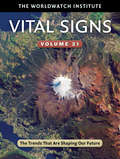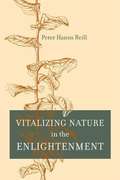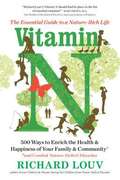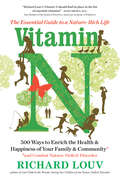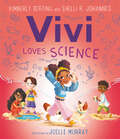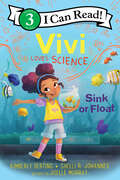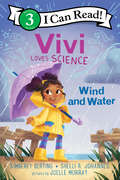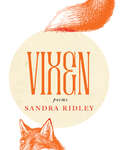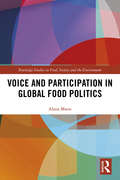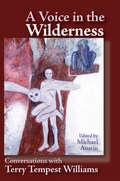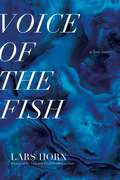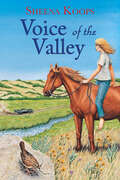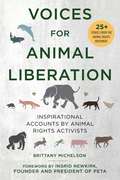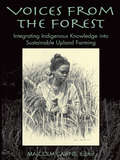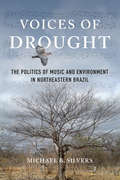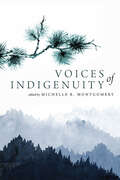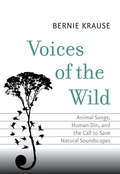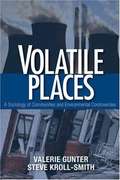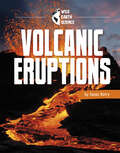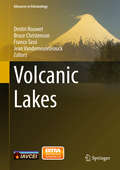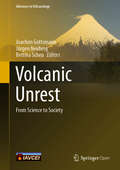- Table View
- List View
Vital Signs 2009 (Vital Signs)
by The Worldwatch InstituteThis sixteenth volume of Worldwatch's Vital Signs series makes it clear that climate change is both a growing driver of and an increasingly important motivator behind the world's leading economic, social, and environmental trends
Vital Signs 2010 (Vital Signs)
by The Worldwatch InstituteThis seventeenth edition of the Worldwatch Institute series shows that climate change continues to cast a long shadow over the world's leading economic, social, and environmental trends.
Vital Signs 2011 (Vital Signs)
by The Worldwatch InstituteThis eighteenth volume of the Worldwatch Institute series makes it clear that the Great Recession affects many of the world's leading economic, social, and environmental trends - but that the impact can be very different by country.
Vital Signs Volume 21: The Trends That Are Shaping Our Future (Vital Signs #Volume 20)
by The Worldwatch InstituteVital Signs Volume 21 is all about growth. From natural disasters to cars to organic farming, the two dozen trends examined here indicate both increasing pressure on natural resources and scaled up efforts to live more sustainably. In 2012, world auto production set yet another record with passenger-car production rising to 66.7 million. That same year, the number of natural disasters climbed to 905, roughly one hundred more than the 10-year annual average, and 90 percent were weather related. Alongside these mounting pressures come investments in renewable energy and sustainable agriculture. The number of acres of land farmed organically has tripled since 1999, though it still makes up less than 1% of total farmland. Not all the statistics are going up. Key measures of development aid have fallen, as have global commodity prices. Yet the overall trend is expansion, both for the good and ill of the planet. Vital Signs provides the latest data available, but its value goes beyond simple numbers. Through insightful analysis of global trends, it offers a starting point for those seeking solutions to the future's intensifying challenges.
Vitalizing Nature in the Enlightenment
by Peter Hanns ReillThis study redraws the intellectual map of the Enlightenment and reassesses the legacy of that highly influential period for us today. Peter Hanns Reill argues that in the middle of the eighteenth century, a major shift occurred in the way Enlightenment thinkers conceived of nature that caused many of them to reject the prevailing doctrine of mechanism and turn to a vitalistic model to account for phenomena in natural history, the life sciences, and chemistry.
Vitamin N: The Essential Guide to a Nature-Rich Life
by Richard LouvA complete prescription for connecting with the power and joy of the natural world right now, with 500 activities for children and adults; Dozens of inspiring and thought-provoking essays; and Scores of informational websites Down-to-earth advice. Vitamin N is a comprehensive and practical guidebook for the whole family and the wider community, including tips not only for parents eager to share nature with their kids but also for those seeking nature-smart schools, medical professionals, and even careers. It is a dose of pure inspiration, reminding us that looking up at the stars or taking a walk in the woods is as exhilarating as it is essential, at any age.
Vitamin N: The Essential Guide to a Nature-Rich Life
by Richard LouvFrom the author of the New York Times bestseller that defined nature-deficit disorder and launched the international children-and-nature movement, Vitamin N (for “nature”) is a complete prescription for connecting with the power and joy of the natural world right now, with500 activities for children and adultsDozens of inspiring and thought-provoking essaysScores of informational websitesDown-to-earth adviceIn his landmark work Last Child in the Woods, Richard Louv was the first to bring widespread attention to the alienation of children from the natural world, coining the term nature-deficit disorder and outlining the benefits of a strong nature connection--from boosting mental acuity and creativity to reducing obesity and depression, from promoting health and wellness to simply having fun. That book “rivaled Rachel Carson’s Silent Spring” (the Cincinnati Enquirer), was “an absolute must-read for parents” (the Boston Globe), and “an inch-thick caution against raising the fully automated child” (the New York Times). His follow-up book, The Nature Principle, addressed the needs of adults and outlined a “new nature movement and its potential to improve the lives of all people no matter where they live” (McClatchy Newspapers).Vitamin N is a one-of-a-kind, comprehensive, and practical guidebook for the whole family and the wider community, including tips not only for parents eager to share nature with their kids but also for those seeking nature-smart schools, medical professionals, and even careers. It is a dose of pure inspiration, reminding us that looking up at the stars or taking a walk in the woods is as exhilarating as it is essential, at any age.
Vivi Loves Science (Loves Science)
by Kimberly Derting Shelli R. JohannesVivi loves science! In this STEM-themed picture book, part of a series about girls who love science, Vivi and her classmates go on a field trip to the ocean to investigate tide pools. A must-have for fans of Rosie Revere, Engineer and What Do You Do with an Idea? and anyone who loves to ask questions and learn about the world. Features a glossary and fun tide pool activity to do at home.In the companion to Cece Loves Science and Libby Loves Science, Vivi and her classmates take a field trip to the beach to study tide pools. With help from her teacher and a park ranger, Vivi and her friends make aquascopes, participate in a marine-inspired scavenger hunt, and learn about different species that call the ocean home.At the end of their trip, there’s one more surprise for Vivi! Full of fun facts about marine biology and conservation, Vivi Loves Science is a perfect pick for aspiring scientists, classrooms, and fans of Andrea Beaty’s Ada Twist, Scientist.Features a glossary and instructions on how to make your own aquascope and tide pool at home.
Vivi Loves Science: Sink or Float (I Can Read Level 3)
by Kimberly Derting Shelli R. JohannesVivi loves science! In this STEM-themed Level 3 I Can Read! title, Vivi and her friends visit the aquarium and are introduced to the concepts of density and buoyancy. A great choice for aspiring scientists, emerging readers, and fans of Andrea Beaty’s Ada Twist, Scientist. Includes activities, a glossary, and a fun experiment to do at home. Vivi loves science—and experimenting! In this Level 3 I Can Read! title, Vivi and her classmates visit an aquarium and learn about the creatures living in the big display tank. But why do some fish swim while others bury themselves in the sand? Vivi will have to experiment to find out!The Loves Science books introduce readers to girls who love science, as well as basic concepts of science, technology, engineering, and math. This Level 3 I Can Read! explores swimming, sinking, floating, and density, and includes an experiment to try at home. A great pick for newly independent readers and an ideal companion to Cece Loves Science: Push and Pull and Libby Loves Science: Mix and Measure.
Vivi Loves Science: Wind and Water (I Can Read Level 3)
by Kimberly Derting Shelli R. JohannesVivi loves science! In this STEM-themed Level 3 I Can Read! title, Vivi helps her community clean up the beach after a storm and learns about how wind and water shape the landscape. A great choice for aspiring scientists, new readers, and fans of Andrea Beaty’s Ada Twist, Scientist. Includes activities, a glossary, and a fun science experiment to do at home. Vivi loves science—and experimenting! In this Level 3 I Can Read! title, Vivi volunteers to help with the clean-up efforts at the beach after a big storm hits her town. But why does the beach look so different than before? Vivi and her friends will have to ask a lot of questions, learn about erosion, and conduct experiments to find out!The Loves Science books introduce readers to girls who love science, as well as basic concepts of science, technology, engineering, and math. This Level 3 I Can Read! explores how wind and water impact different landscapes, and includes an experiment about erosion to try at home or school, as well as a glossary. A great pick for newly independent readers and an ideal companion to Cece Loves Science: Push and Pull; Libby Loves Science: Mix and Measure; and Vivi Loves Science: Sink or Float.
Vixen
by Sandra RidleyGriffin Poetry Prize finalist Sandra Ridley offers a breathtaking, harrowing immersion in cruelty behind different veils: the medieval hunt, ecological collapse, and intimate partner violence. Sparked by a haunting chance encounter with a fox, and told in six chapters of varying form, Vixen is as visceral as it is mysterious, sensuous as it is terrifying. "Thicket" introduces us to stalking being akin to hunting; the similar threat of terror and—too often—a violent end. "Twitchcraft" locates the hunt in the home, the wild in the domestic, while "Season of the Haunt" explores the unrelenting nature of hunting. "Stricken" asks common questions that often implicitly justify such violence: Is the harassment ‘bad enough’ to allow us to label it criminal? Has all control been taken? Is the fear reasonable? Vixen propels us to examine the nature of empathy, what it means to be a compassionate witness —and what happens when brutality is so ever-present that we become numb. This is a beautiful, difficult, wild tapestry of defiance and survival.
Voice and Participation in Global Food Politics (Routledge Studies in Food, Society and the Environment)
by Alana MannAs awareness of the commodification of food for profit at the expense of our health and the planet grows, this book foregrounds the communicative dimensions of resistance by food movements. Voice and participation are argued by the author to be the means through which rural and urban communities can, and in many cases do, resist the capture of value by corporate actors and work to democratise their foodscapes. Her critical analysis of meaning-making under neo-liberalism suggests that agroecology, as a socially activating form of agriculture within a food sovereignty framework, provides an example of social learning relevant across rural/urban and North/South divides. Embracing indigenous knowledge, gender equity and postcolonial theory, this approach mobilises growers and eaters to contest the power structures that shape their food environments, and also to focus on social and economic justice within their communities, particularly in the context of climate change. Participatory ecologies that incorporate these forms of social learning encourage the co-creation of inclusive foodscapes and politicise food justice. Such a positive framing of resistance through horizontal pedagogy, participation, communication and social learning processes contrasts with the vertical dissemination structure of the corporatised food regime and takes vital steps towards a more democratic food system. Voice and Participation in Global Food Politics will be of interest to scholars of agri-food, transdisciplinary food studies and political economy of food systems. It will also be of relevance to NGOs and policymakers.
Voice in the Wilderness: Conversations with Terry Tempest Williams
by Michael AustinWith her distinctive, impassioned voice and familiar felicity of language, Terry Tempest Williams talks about wilderness and wildlife, place and eroticism, art and literature, democracy and politics, family and heritage, Mormonism and religion, writing and creativity, and other subjects that engage her agile mind—in a set of interviews gathered and introduced by Michael Austin to represent the span of her career as a naturalist, author, and activist.
Voice of the Fish: A Lyric Essay
by Lars HornLars Horn’s Voice of the Fish, the latest Graywolf Press Nonfiction Prize winner, is an interwoven essay collection that explores the trans experience through themes of water, fish, and mythology, set against the backdrop of travels in Russia and a debilitating back injury that left Horn temporarily unable to speak. In Horn’s adept hands, the collection takes shape as a unified book: short vignettes about fish, reliquaries, and antiquities serve as interludes between longer essays, knitting together a sinuous, wave-like form that flows across the book.Horn swims through a range of subjects, roving across marine history, theology, questions of the body and gender, sexuality, transmasculinity, and illness. From Horn’s upbringing with a mother who used them as a model in photos and art installations—memorably in a photography session in an ice bath with dead squid—to Horn’s travels before they were out as trans, these essays are linked by a desire to interrogate liminal physicalities. Horn reexamines the oft-presumed uniformity of bodily experience, breaking down the implied singularity of “the body” as cultural and scientific object. The essays instead privilege ways of seeing and being that resist binaries, ways that falter, fracture, mutate. A sui generis work of nonfiction, Voice of the Fish blends the aquatic, mystical, and physical to reach a place beyond them all.
Voice of the Valley
by Sheena KoopsVoice of the Valley is a poetic, multi-layered, coming-of-age story inspired by the controversial flooding of Saskatchewan's Souris Valley. Onja Claibourn is almost fifteen. Her world is one of sage, buffalo bills, brown-eyed susans, cactus, flax, buckbrush, foxtail and orange moss—the world of the valley just beyond the family farm. Old roads twist like a game of snakes and ladders into the valley. Onja and her horse Ginger spend their summer days in exploration. But things begin to change when Onja discovers first an archeological dig and then the startling fact that there is a plan to dam and flood her valley. She cannot contemplate this change to the landscape she loves so much. And when she also discovers sixteen-year-old Etthen, working with the archaeologists, she begins those first faltering footsteps toward a totally unfamiliar landscape—romantic love. Onja Claibourn is a wonderfully complex and very real character—innocent, wise, shy, stubborn, playful, and caring. The other major character in the novel is the prairie landscape itself—huge sky, harsh sun, rolling hills, sweeping fields of grain.
Voices for Animal Liberation: Inspirational Accounts by Animal Rights Activists
by Brittany MichelsonImmerse yourself in the world of animal rights protests, campaigns, demonstrations, outreach, rescue, and so much more. In today&’s world, voices of the marginalized are in the spotlight and people across the globe are recognizing animal rights as a social justice movement. During a time of historic actions and victorious campaigns, Voices for Animal Liberation depicts the full spectrum of animal rights activism that is currently at work to create change. This book offers the words of both new and highly influential voices in the movement today, with the intention of inspiring and educating those who are sparked by the vision of a more ethical world. Including a foreword by Ingrid Newkirk, founder and president of PETA and arguably one of the most prolific figures in the animal rights movement, other contributors include: Jasmine Afshar, army veteranChase Avior, actor and filmmakerGene Baur, founder of Farm SanctuaryDotsie Bausch, Olympic medalist and founder of Switch4GoodAlex Bez, founder and director of Amazing Vegan OutreachMatthew Braun, former investigator of farms and slaughterhousesSaengduean Lek Chailert, founder of Save Elephant FoundationAmy Jean Davis, founder of Los Angeles Animal SaveKaren Davis, founder of United Poultry ConcernsSean Hill, award-winning multidisciplinary artist and humanitarianWayne Hsiung, cofounder of Direct Action Everywhere (DxE)Gwenna Hunter, event coordinator for Vegan Outreach and founder of Vegans of LAAnita Krajnc, founder of the Save MovementCory Mac a&’Ghobhainn, organizer with Progress for ScienceJo-Anne McArthur, photographer and founder of We Animals MediaZafir Molina, truth seeker and movement artistShaun Monson, documentary filmmakerAlexandra Paul, actress and cohost of Switch4GoodBrittany Peet, Director of Captive Animal Law Enforcement for PETAJill Robinson, founder and CEO of Animals AsiaZoe Rosenberg, founder of Happy Hen Animal SanctuaryDani Rukin, citizen journalist for JaneUnchained NewsJasmin Singer, cofounder of Our Hen House and Senior Features Editor for VegNewsKathy Stevens, founder of Catskill Animal SanctuaryNatasha & Luca, &“That Vegan Couple,&” social media influencersWill Tuttle, visionary author and speakerGillian Meghan Walters, creator of MummyMOO project Connect with activists from different backgrounds as they reveal their perspectives on animal rights, their experiences taking action for animals, the challenges they've faced, and the meaning of activism in their lives.
Voices from the Forest: Integrating Indigenous Knowledge into Sustainable Upland Farming
by Malcolm CairnsThis handbook of locally based agricultural practices brings together the best of science and farmer experimentation, vividly illustrating the enormous diversity of shifting cultivation systems as well as the power of human ingenuity. Environmentalists have tended to disparage shifting cultivation (sometimes called 'swidden cultivation' or 'slash-and-burn agriculture') as unsustainable due to its supposed role in deforestation and land degradation. However, a growing body of evidence indicates that such indigenous practices, as they have evolved over time, can be highly adaptive to land and ecology. In contrast, 'scientific' agricultural solutions imposed from outside can be far more damaging to the environment. Moreover, these external solutions often fail to recognize the extent to which an agricultural system supports a way of life along with a society's food needs. They do not recognize the degree to which the sustainability of a culture is intimately associated with the sustainability and continuity of its agricultural system. Unprecedented in ambition and scope, Voices from the Forest focuses on successful agricultural strategies of upland farmers. More than 100 scholars from 19 countries--including agricultural economists, ecologists, and anthropologists--collaborated in the analysis of different fallow management typologies, working in conjunction with hundreds of indigenous farmers of different cultures and a broad range of climates, crops, and soil conditions. By sharing this knowledge--and combining it with new scientific and technical advances--the authors hope to make indigenous practices and experience more widely accessible and better understood, not only by researchers and development practitioners, but by other communities of farmers around the world.
Voices of Drought: The Politics of Music and Environment in Northeastern Brazil
by Michael B. SilversIn Voices of Drought, Michael B. Silvers proposes a scholarship focused on environmental justice to understand key questions in the study of music and the environment. His ecomusicological perspective offers a fascinating approach to events in Ceará, a northeastern Brazilian state affected by devastating droughts. These crises have a profound impact on social difference and stratification, and thus on forró music in the sertão (backlands) of the region. At the same time, the complex interactions of popular music and social conditions also help create the environment. Silvers offers case studies focused on the sertão that range from the Brazilian wax harvested in Ceará for use in early wax cylinder sound recordings to the drought- and austerity-related cancelation of Carnival celebrations in 2014-16. Unearthing links between music and the environmental and social costs of drought, his daring synthesis explores ecological exile, poverty, and unequal access to water resources alongside issues like corruption, prejudice, unbridled capitalism, and expanding neoliberalism.
Voices of Indigenuity (Intersections in Environmental Justice)
by Michelle MontgomeryVoices of Indigenuity collects the voices of the Indigenous Speaker Series and multigenerational Indigenous peoples to introduce best practices for traditional ecological knowledge (TEK). In this edited collection, presenters from the series, both within and outside of the academy, examine the ways they have utilized TEK for inclusive teaching practices and in environmental justice efforts. Advocating for and providing an expansion of place-based Indigenized education that infuses Indigenous epistemologies for student success in both K–12 and higher education curricula, these essays explore topics such as land fragmentation, remote sensing, and outreach through the lens of TEK, demonstrating methods of fusing learning with Indigenous knowledge (IK). Contributors emphasize the need to increase the perspectives of IK within institutionalized knowledge beyond being co-opted into non-Indigenous frameworks that may be fundamentally different from Indigenous ways of thinking. Decolonizing current harmful pedagogical curricula and research training about the natural world through an Indigenous- guided approach is an essential first step to rebuilding a healthy relationship with our environment while acknowledging that all relationships come with an ethical responsibility. Voices of Indigenuity captures the complexities of exploring the contextu- alized meanings for why TEK should be integrated into Western environmental science processes and frameworks while rooted in Indigenous studies programs.
Voices of the Wild
by Bernie KrauseWild Soundscapes is the first comprehensive guide to listening to--and recording--nature. Learn how to tune in to nature's biophonies, or creature symphonies; how to use simple microphones to hear more; and how to record, mix, and play with sounds you gather. Keep it simple or launch yourself into a new creative field. Whether you're an amateur naturalist, novice field recordist, musician, want to create your own natural sound library, or just want to gain further appreciate of the natural world, this is the book for you. Bernie Krause, a professional field recordist and bioacoustician, shares his expertise in exploring nature's sonic landscapes. Wild Soundscapes comes with a full-length CD, narrated by Krause, sampling a variety of natural sounds: the crashing sea, the singing of ants, the bugling of Yellowstone elk, the plop of falling Costa Rican crabs, and more. With the help of this CD, Krause demonstrates techniques and tricks for field recording success.
Volatile Places: A Sociology of Communities and Environmental Controversies
by Steve Kroll-Smith Valerie J. GunterVolatile Places: A Sociology of Communities and Environmental Controversies is a thoughtful guide to the spirited public controversies that inevitably occur when environments and human communities collide. The movie "An Inconvenient Truth" based on the environmental activism of Al Gore and the devastation of Hurricane Katrina are specifically highlighted. Authors Valerie Gunter and Steve Kroll-Smith begin with a simple observation and offer a provocative case study approach to the investigation of community and environmental controversies.
Volcanes explosivos (¡Arriba la Lectura! Level V #65)
by Jill BryantNIMAC-sourced textbook <p><p> Los volcanes son aberturas en la tierra que llegan hasta la corteza terrestre. Cuando un volcán entra en erupción, despide roca fundida, gas y cenizas de forma repentina y violenta. Hay volcanes sobre la tierra y debajo del agua. Aprende sobre la ciencia de los volcanes, dónde están y por qué se forman. Quizás algún día quieras ser vulcanólogo y ayudar a comprender con más detalle cómo se comportan los volcanes.
Volcanic Eruptions (Wild Earth Science)
by Isaac KerryA rumble deep inside Earth. Hot, flowing magma is trapped and needs a way to escape. Pressure builds and causes a break in the surface. Eruption! Volcanic eruptions can shoot lava, ash, and smoke over a huge area. Why do they happen? Learn about volcanoes, what causes them, and how to be prepared.
Volcanic Lakes
by Franco Tassi Dmitri Rouwet Bruce Christenson Jean VandemeulebrouckThis book aims to give an overview on the present state of volcanic lake research, covering topics such as volcano monitoring, the chemistry, dynamics and degassing of acidic crater lakes, mass-energy-chemical-isotopic balance approaches, limnology and degassing of Nyos-type lakes, the impact on the human and natural environment, the eruption products and impact of crater lake breaching eruptions, numerical modeling of gas clouds and lake eruptions, thermo-hydro-mechanical and deformation modeling, CO2 fluxes from lakes, volcanic lakes observed from space, biological activity, continuous monitoring techniques, and some aspects more. We hope to offer an updated manual on volcanic lake research, providing classic research methods, and point towards a more high-tech approach of future volcanic lake research and continuous monitoring.
Volcanic Unrest: From Science To Society (Advances In Volcanology Ser.)
by Joachim Gottsmann Jürgen Neuberg Bettina ScheuThis open access book summarizes the findings of the VUELCO project, a multi-disciplinary and cross-boundary research funded by the European Commission's 7th framework program. It comprises four broad topics:1. The global significance of volcanic unrest2. Geophysical and geochemical fingerprints of unrest and precursory activity3. Magma dynamics leading to unrest phenomena4. Bridging the gap between science and decision-makingVolcanic unrest is a complex multi-hazard phenomenon. The fact that unrest may, or may not lead to an imminent eruption contributes significant uncertainty to short-term volcanic hazard and risk assessment. Although it is reasonable to assume that all eruptions are associated with precursory activity of some sort, the understanding of the causative links between subsurface processes, resulting unrest signals and imminent eruption is incomplete. When a volcano evolves from dormancy into a phase of unrest, important scientific, political and social questions need to be addressed. This book is aimed at graduate students, researchers of volcanic phenomena, professionals in volcanic hazard and risk assessment, observatory personnel, as well as emergency managers who wish to learn about the complex nature of volcanic unrest and how to utilize new findings to deal with unrest phenomena at scientific and emergency managing levels. This book is open access under a CC BY license.
